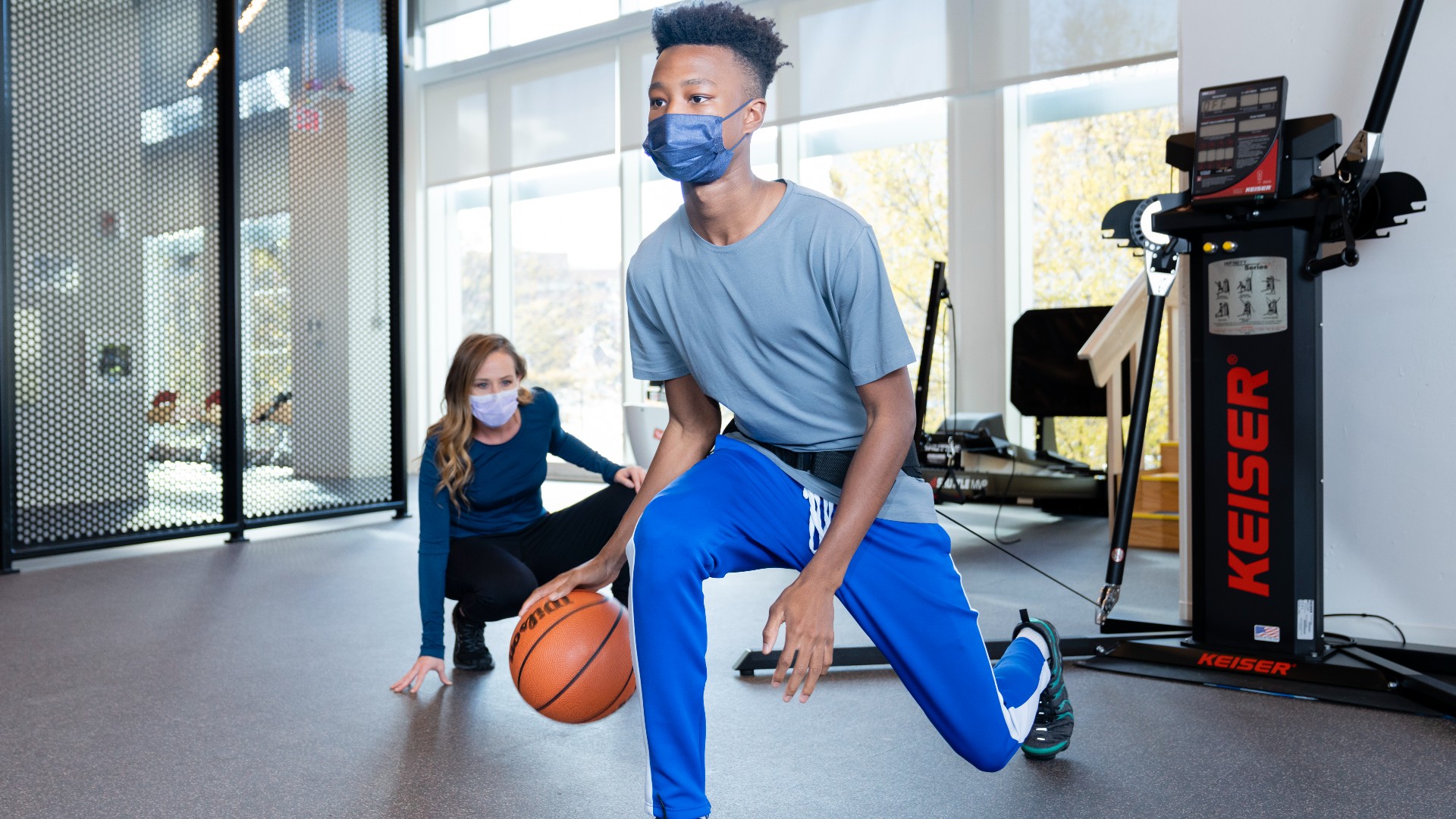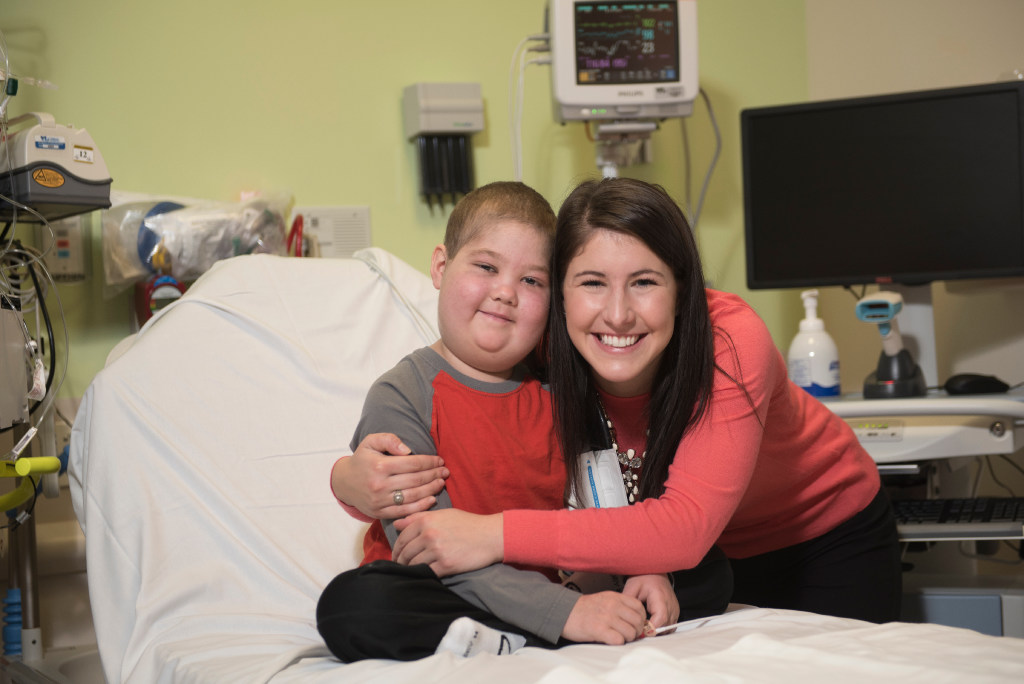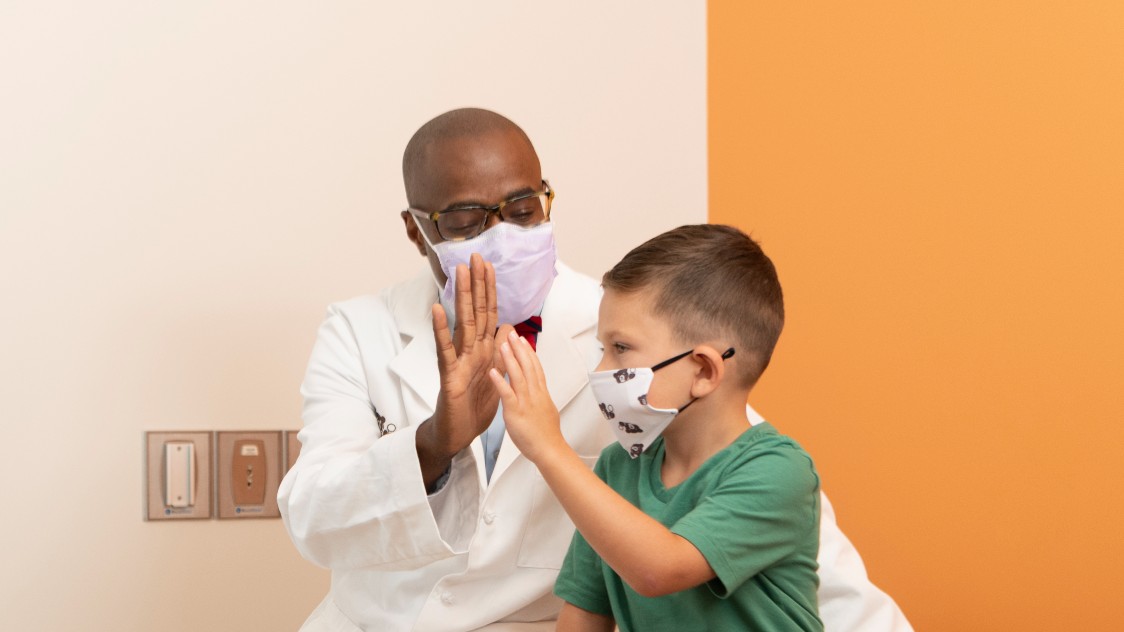Condition
Pediatric Bone Tumors
Children’s National Hospital has a team of individuals who are highly skilled and experienced in the treatment of bone tumors, including osteosarcoma and Ewing sarcoma. Children’s National patients have access to the most current therapies in treating pediatric cancer through Children’s Oncology Group’s protocols and other clinical trials.
In addition, the Patient and Family Support Program Cancer and Blood Disorders provides comprehensive mental health and psychosocial services and helpful resources for all patients treated in the Center for Cancer and Blood Disorders, as well as patients’ parents and siblings.
Get more information on the IGNITE clinical trial program.
Frequently Asked Questions
What is osteogenic sarcoma?
Also called osteosarcoma, osteogenic sarcoma is one of the most common types of bone cancer in children and accounts for nearly 3% of all childhood cancers. About 400 children are diagnosed with osteosarcoma each year. The disease usually occurs in the long bones, such as the arms (humerus), legs (femur/tibia) and pelvis. It rarely occurs in the jaw and fingers, but often occurs at the ends of these bones near growth plates.
Osteosarcoma affects children most often between 10 and 25 years of age. This cancer is also more prevalent in males than in females, possibly because of the rapid growth rate at this age. Prior to adolescence, the percentage of affected males and females is equal. Osteogenic sarcoma cancer cells can also spread (metastasize) to other areas of the body. Most commonly, these cells spread to the lungs. However, bones, kidneys, the adrenal gland, the brain and the heart can also be sites of metastasis.
What causes osteogenic sarcoma?
Repeated trauma
It has been suggested that repeated trauma to an area may be a risk factor for developing this type of cancer. It is uncertain whether trauma is a cause or effect of the disease. Cancer lesions in the bone can make that area of the bone weaker, thus, making injury more likely. However, repeated injuries to a certain area of the bone may lead to an increased production of osteoid tissue to repair the damaged area. The rapid production of osteoid tissue may lead to the malignancy. It is thought, most often, that injury simply brings the condition to attention and has no causal relationship.
Genetics
Genetics may play an important role in developing osteosarcoma. Children and adults with other hereditary abnormalities, including exostoses (bony growths), retinoblastoma, Ollier's disease, osteogenesis imperfecta, polyostotic fibrous dysplasia and Paget's disease, have an increased risk for developing osteosarcoma.
Exposure to ionizing irradiation
This form of cancer has also been linked to exposure to ionizing irradiation associated with radiation therapy for other types of cancer (i.e., Hodgkin and non-Hodgkin disease).
What are the symptoms of osteogenic sarcoma?
The following are the most common symptoms of osteogenic sarcoma. However, each child may experience symptoms differently. Symptoms may include, but are not limited to, the following:
- Pain (sharp or dull) at the site of the tumor
- Swelling and/or redness at the site of the tumor
- Increased pain with activity or lifting
- Limping
- Decreased movement of the affected limb
The symptoms may have been present over a short period of time or may have been occurring for six months or more. Often, an injury brings a child into a medical facility where an x-ray may indicate suspicious bone lesions. The symptoms of osteogenic sarcoma may resemble other conditions or medical problems. Always consult your child's physician for a diagnosis.
How is osteogenic sarcoma diagnosed?
In addition to a complete medical history and physical examination of your child, diagnostic procedures for osteogenic sarcoma may include:
- X-rays use invisible electromagnetic energy beams to produce images of internal tissues, bones and organs onto film. This test is used to measure and evaluate the curve.
- Bone scans are a nuclear imaging method that evaluates any degenerative and/or arthritic changes in the joints. Bone scans detect bone diseases and tumors, determine the cause of bone pain or inflammation and rule out any infection or fractures.
- Magnetic resonance imaging (MRI) – is a diagnostic procedure that uses a combination of large magnets, radiofrequencies, and a computer to produce detailed images of organs and structures within the body. This test is done to rule out any associated abnormalities of the spinal cord and nerves.
- Computer-assisted tomography scan (CT or CAT scan) is a diagnostic imaging procedure that uses a combination of x-rays and computer technology to produce cross-sectional images (often called slices), both horizontally and vertically, of the body. A CT scan shows detailed images of any part of the body, including the bones, muscles, fat and organs. CT scans are more detailed than general x-rays.
- Complete blood count (CBC) is a measurement of size, number and maturity of different blood cells in a specific volume of blood.
- Blood tests, including blood chemistries.
- Biopsy of the tumor, which uses invisible electromagnetic energy beams to produce images of internal tissues, bones, and organs onto film.
- Bone marrow aspiration and/or biopsy. This procedure involves taking a small amount of bone marrow fluid (aspiration) and/or solid bone marrow tissue (called a core biopsy), usually from the hip bones, to be examined for the number, size and maturity of blood cells and/or abnormal cells.
Treatment
The specialists at Children’s National Hospital aim not only to cure the cancer, but also to minimize the side effects of treatment. Specific treatment for a bone tumor will be determined by a child's physician based on the:
- Child's age, overall health, and medical history
- Type, location, and size of the tumor
- Extent of the disease
Treatment may include one, or more, of the following:
- Surgery
- Cyberknife therapy
- Radiation therapy
- Amputation
- Resections for metastases, such as pulmonary resections of cancer cells in the lung
- Rehabilitation including physical and occupational therapy, and psychosocial adaptation
- Prosthesis fitting and training
- Antibiotics to prevent and treat infections
- Continual follow-up care to determine response to treatment, detect recurrent disease and manage late effects of treatment
Long-term outlook for a child with Ewing sarcoma or osteosarcoma
The factors for determining the prognosis and long-term survival of children with Ewing sarcoma or osteosarcoma include the following: Prognosis greatly depends on the:
- Child’s age
- Extent of the disease (presence or absence of metastasis)
Other factors that may play role in the outcome include:
- Size and location of the tumor
- Tumor's response to therapy
- Child's tolerance of specific medications, procedures or therapies
As with any cancer, prognosis and long-term survival can vary greatly from child to child. Every child is unique and treatment and prognosis is structured around the child's needs. Prompt medical attention and aggressive therapy are important for the best prognosis. Continuous follow-up care is essential. Late effects of radiation and chemotherapy, as well as second malignancies, can occur in survivors of Ewing sarcoma and osteosarcoma. New methods are continually being discovered to improve treatment and to decrease side effects.
Providers Who Treat Bone Tumors

Robert Mikael Henshaw, MD
- Director, Orthopaedic Oncology
- Orthopaedic Surgeon
- Bone and Soft Tissue Tumor Specialist
Robert Mikael Henshaw, MD
Locations
Departments
Nita Louise Seibel, MD
Locations
Departments
Jul 22, 2024
Helping Maddie to Live Life to the FullestMaddie is a lively, creative teen who loves to act. Research at Children's National Hospital helps to ensure that her rare disease doesn"t upstage her big theater plans or her love of life.
Jun 27, 2024
Convenient Care for CharlotteWhen Charlotte was a toddler, a respiratory illness led to a diagnosis of a rare and dangerous immune deficiency called ICF syndrome. A bone marrow transplant at age 5 at Children’s National helped save her life.
May 20, 2024
Omid Conquers Fear with MusicOmid never liked going to the dentist. Dr. Aleger changed that with a little trust, and his favorite tunes.
Departments that Treat Bone Tumors

Oncology
Our oncology (cancer) team provides personalized treatment plans for children with cancer, including access to clinical trials.

Sarcoma Surgery
Surgeons at Children’s National perform biopsies, tumors removals and other procedures at a high volume, collaborating with experts in oncology, musculoskeletal radiology, pathology, radiation oncology, genetics, physical therapy and psychology. Their wealth of experience directly translates into superior skill and enables them to treat every type of tumor, even the most complex.

Orthopaedic Surgery and Sports Medicine
From sprains and strains to complex congenital conditions, Children’s National Hospital offers one of the most experienced pediatric orthopaedic practices in the nation with experience in treating all areas from head to toe.

Autologous Blood and Marrow Transplantation Program
Our goal is to provide specialized therapy for children in an effort to restore their health using the most advanced and least invasive treatments possible.

Solid Tumor Program
Our Solid Tumor Program has a dedicated team of sarcoma experts who specialize in the newest treatments and clinical trials.






